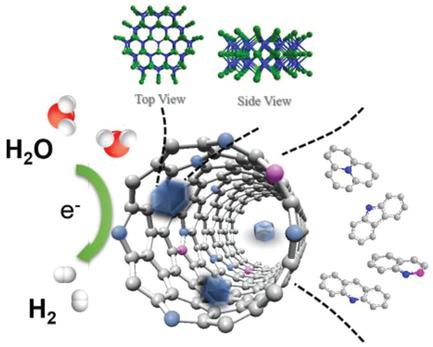当前位置:
X-MOL 学术
›
Adv. Funct. Mater.
›
论文详情
Our official English website, www.x-mol.net, welcomes your feedback! (Note: you will need to create a separate account there.)
Polyoxometalate‐Derived Hexagonal Molybdenum Nitrides (MXenes) Supported by Boron, Nitrogen Codoped Carbon Nanotubes for Efficient Electrochemical Hydrogen Evolution from Seawater
Advanced Functional Materials ( IF 19.0 ) Pub Date : 2018-12-13 , DOI: 10.1002/adfm.201805893 Jun Miao 1, 2 , Zhongling Lang 3 , Xinyu Zhang 4 , Weiguang Kong 1 , Ouwen Peng 1 , Ye Yang 2 , Shuangpeng Wang 2 , Jiaji Cheng 5 , Tingchao He 5 , Abbas Amini 6 , Qingyin Wu 7 , Zhiping Zheng 4, 8 , Zikang Tang 2 , Chun Cheng 1
Advanced Functional Materials ( IF 19.0 ) Pub Date : 2018-12-13 , DOI: 10.1002/adfm.201805893 Jun Miao 1, 2 , Zhongling Lang 3 , Xinyu Zhang 4 , Weiguang Kong 1 , Ouwen Peng 1 , Ye Yang 2 , Shuangpeng Wang 2 , Jiaji Cheng 5 , Tingchao He 5 , Abbas Amini 6 , Qingyin Wu 7 , Zhiping Zheng 4, 8 , Zikang Tang 2 , Chun Cheng 1
Affiliation

|
MXenes and doped carbon nanotubes (CNTs) have entered into research arenas for high‐rate energy storage and conversion. Herein, a method of postsynthesis of MXenes in boron, nitrogen codoped CNTs (BNCNTs) is reported with their electrocatalytical hydrogen evolution performance. The encapsulation of hexagonal molybdenum nitrate nanoparticles (h‐MoN NPs) into BNCNTs protects h‐MoN NPs from agglomeration and poisoning in the complex environment. In principle, the synergism of B and N dopants on the doped CNTs and confined h‐MoN NPs produces extremely active sites for electrochemical hydrogen evolution. Density functional theory calculations reveal that the active sites for hydrogen evolution originate from the synergistic effect of h‐MoN(001)/CN (graphitic N doping) and h‐MoN(001)/BNC. The h‐MoN@BNCNT electrocatalyst exhibits a small overpotential of 78 mV at 10 mA cm−2 and Tafel slope of 46 mV per decade, which are dramatically improved over all reported MoN‐based materials and doped CNTs. Additionally, it also exhibits outstanding electrochemical stability in environments with various pH values and seawater media from South China Sea.
中文翻译:

多金属氧酸盐衍生的六方氮化钼(MXenes),由硼,氮共掺杂碳纳米管支撑,可有效地从海水中释放出电化学氢
MXene和掺杂的碳纳米管(CNTs)已进入研究领域,以实现高效率的能量存储和转换。在此,报道了在硼,氮共掺杂的CNT(BNCNT)中MXenes的后合成方法及其电催化氢释放性能。将六边形硝酸钼钼纳米颗粒(h-MoN NPs)封装到BNCNT中可以保护h-MoN NPs在复杂环境中不发生团聚和中毒。原则上,掺杂的CNT上的B和N掺杂剂与受限的h-MoN NP上的协同作用为电化学放氢产生了极为活跃的位点。密度泛函理论计算表明,析氢的活性位点源自h-MoN(001)/ CN(石墨氮掺杂)和h-MoN(001)/ BNC的协同作用。每十年的−2和Tafel斜率为46 mV,与所有报道的基于MoN的材料和掺杂的CNT相比,均得到了显着改善。此外,它在具有各种pH值和南海海水介质的环境中也表现出出色的电化学稳定性。
更新日期:2018-12-13
中文翻译:

多金属氧酸盐衍生的六方氮化钼(MXenes),由硼,氮共掺杂碳纳米管支撑,可有效地从海水中释放出电化学氢
MXene和掺杂的碳纳米管(CNTs)已进入研究领域,以实现高效率的能量存储和转换。在此,报道了在硼,氮共掺杂的CNT(BNCNT)中MXenes的后合成方法及其电催化氢释放性能。将六边形硝酸钼钼纳米颗粒(h-MoN NPs)封装到BNCNT中可以保护h-MoN NPs在复杂环境中不发生团聚和中毒。原则上,掺杂的CNT上的B和N掺杂剂与受限的h-MoN NP上的协同作用为电化学放氢产生了极为活跃的位点。密度泛函理论计算表明,析氢的活性位点源自h-MoN(001)/ CN(石墨氮掺杂)和h-MoN(001)/ BNC的协同作用。每十年的−2和Tafel斜率为46 mV,与所有报道的基于MoN的材料和掺杂的CNT相比,均得到了显着改善。此外,它在具有各种pH值和南海海水介质的环境中也表现出出色的电化学稳定性。



























 京公网安备 11010802027423号
京公网安备 11010802027423号